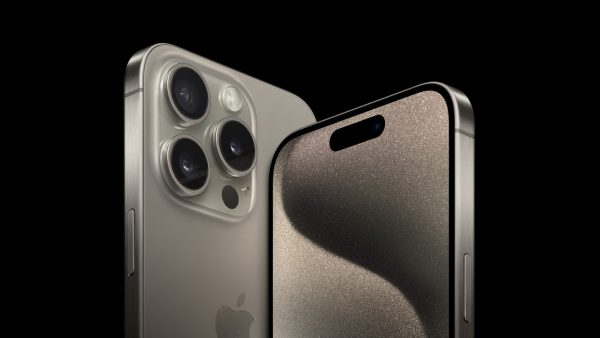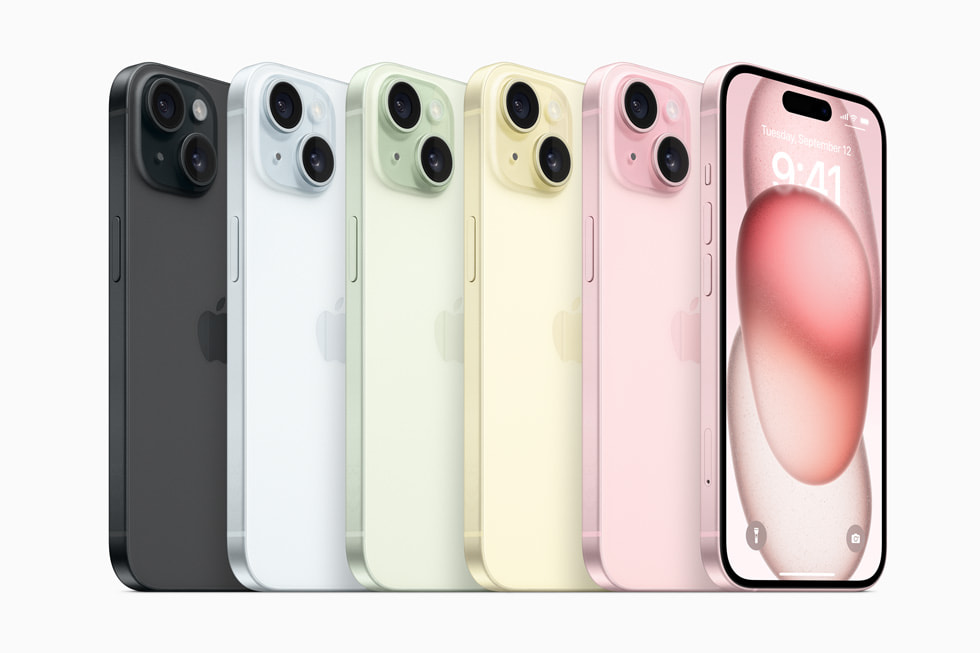On Tuesday, Apple held its annual September event which included the announcement of the iPhone 15 lineup, Apple Watch Series 9 and planned changes addressing the company’s environmental impact. Tuesday’s event was marked by the company’s signature presentation style and production quality.
As was anticipated, Apple transitioned its iPhone lineup from the Lightning connector to USB-C. The change comes exactly 11 years after the original announcement of Lightning, mostly attributed to new laws in the European Union.
The event began quite differently than most, beginning with a compilation of videos from birthdays and transitioning into interviews of people explaining how an Apple device saved their life. Some were involved in a serious car crash and their iPhone automatically called 911, while others were trapped in mountain ranges and used Emergency SOS to be airlifted. The text on the screen then read, “They all celebrated a birthday they thought they’d never have.”
The mood immediately changed and so began Tim Cook, CEO of Apple, with a recap of WWDC23 and the anticipated product announcements.
Get The Daily Illini in your inbox!
Apple Watch Series 9
Featuring a new chipset, the S9 system-in-chip, the speed boosts on the new smartwatch will be noticeable in day-to-day use, according to Apple. With a 30% faster graphics processing unit and 60% more transistors in the central processing unit, animations throughout the operating system may look much smoother.
Thanks to a new Neural Engine, Siri requests will now be processed locally on the device. Requests are now faster and more secure, and common requests will be able to be handled without an internet connection, like starting a workout. Dictation is also 25% more accurate than the Apple Watch Series 8.
The watch will feature a second-generation Ultra Wideband chip, allowing for Precision Finding for iPhones with the same chip, which is currently only the iPhone 15 lineup.
The chip will also allow for connection with HomePod. When a user brings their watch close to their HomePod or HomePod mini, media suggestions will appear, and the user will be able to control their music.
The brightness of the screen will peak at 2,000 nits — double the brightness of the Series 8. Apple says it will also be capable of dimming down to one nit for very dark situations.
The new SiP will also enable a brand-new feature called Double Tap. With Double Tap, the user will be able to tap their thumb and pointer finger together twice in order to activate functions on the watch. The action will activate the main button in the app a user is using, so it can be used to accept a call, stop a timer or snooze an alarm.
Apple Watch Series 9 will be available in a new pink color, along with Starlight, Midnight, silver and PRODUCT(RED) in an aluminum body; or gold, silver and graphite in stainless steel. It will start at $399, and preorders began on Tuesday. The device will be available on Sept. 22.
With another abrupt change in mood, Apple employees ran around appearing very stressed in preparation for a meeting with a “special guest.”
Mother Nature, played by Octavia Spencer, then appeared to interrogate the employees on the grounds of environmental sustainability.
Apple boasted that it is working to remove all plastic from packaging by the end of 2024, is using 100% recycled aluminum in the majority of its products and is in the process of phasing out leather from all products, including Apple Watch bands and iPhone cases.
Tim Cook said that by 2030, all Apple devices will have a net-zero climate impact.
For the Series 9, Apple said it will invest in renewable energy projects around the world to counteract all users’ estimated energy usage for charging throughout the lifetime of the device.
With a slew of environmental practices at play, Apple Watch Series 9 is Apple’s first ever carbon-neutral product, and the box sports a new mark to signify it as such.
With the halt on production of leather products, Apple created a new textile called FineWoven. It will replace leather in Apple Watch bands — including Hermès bands — and iPhone cases.
Apple Watch Ultra 2
The updated Apple Watch Ultra 2 features the same S9 SiP and Ultra Wideband chip as Series 9.
With a new display architecture, the watch features the brightest display Apple has ever created, topping out at a whopping 3,000 nits.
According to Tuesday’s presentation, the watch has been tested across the widest range of altitudes of any Apple product, and the depth app tracks past dives for convenient review.
Battery life remains the same with up to 36 hours of typical use or 72 hours in Low Power Mode.
Apple also transitioned from 100% virgin titanium in the case to 95% recycled. Apple Watch Ultra 2 is also carbon-neutral, but only when paired with an Alpine Loop or Trail Loop — not the Ocean Band.
The device is $799 and is available for preorder as of Tuesday. It will be available on Sept. 22.
iPhone 15 and 15 Plus
The new iPhone 15 and iPhone 15 Plus will feature a new design with contoured edges, the Dynamic Island and the switch to USB-C.
The Dynamic Island, which was previously only available on iPhone 14 Pro and Pro Max, allows the display to wrap around the front-facing camera and FaceID modules and has extra features like Live Activities.
The Super Retina XDR display — Apple’s jargon for OLED — will feature thinner borders while keeping the same 6.1 and 6.7-inch display sizes and support for Dolby Vision. Peak HDR brightness is 1,600 nits, and the peak outdoor brightness is 2,000 nits.
The camera system received a hefty update, featuring a new 48-megapixel main camera, something previously limited to the Pro models. Pixels are grouped together by four, averaging the value of the pixels and providing better low-light performance. The Photonic Engine then combines this image with a full resolution image, resulting in a 24-megapixel photo with extremely high clarity.
One hundred percent of pixels are focus pixels, allowing for an especially clear shot.
The 2x telephoto camera and sensor-shift optical image stabilization allow for continuous zoom.
Portrait Mode will receive a hefty update as well. Apple said the camera will automatically capture rich depth information, even without Portrait Mode being turned on. According to the presentation, this means a user can choose to add portrait mode after a photo has been captured. Improved focus and depth control means users can also change the subject of a Portrait Mode shot after the fact.
iPhone 15 and 15 Plus will have the same A16 Bionic chipset as last year’s models.
According to Apple, the Plus variant will have an increase in battery size, though the extent of this update is unclear.
The iPhone 15 lineup receives the same second-generation Ultra Wideband chip as the Apple Watch lineup, allowing for more precise location services, according to Apple. Precision Finding will work from three times further away and will also work for locating friends in crowded areas.
Apple said phone calls will now have better audio quality thanks to machine learning which prioritizes the users voice and cancels out background noise.
Roadside assistance texting is now available through satellite and is included for free for the first two years.
The devices will come with upgraded woven charging cables, the same ones that come with the iMac lineup. AirPods Pro will also now be produced with USB-C, and they can be plugged directly into an iPhone in order to charge.
iPhone 15 will start at $799 and iPhone 15 Plus will start at $899. The devices are available in muted shades of pink, yellow, green, blue and black. Preorders begin on Friday and they will be available beginning Sept. 22.

iPhone 15 Pro and Pro Max
iPhone 15 Pro and iPhone 15 Pro Max both received the same redesign as the standard iPhone 15. Rather than aluminum, though, the Pro lineup features titanium — a material that has not previously been used in iPhones.
With the material’s high durability and low weight, iPhone 15 Pro is the lightest Pro phone Apple has released.
The grade 5 titanium features a brushed finish and is available in four colors: Black Titanium, White Titanium, Blue Titanium and Natural Titanium.
The Pro lineup has the thinnest display borders on an iPhone ever while keeping the same 6.1 and 6.7-inch display sizes. This means the body dimensions have decreased slightly.
According to Apple, the phones’ new internal structure means that repairs are now easier and the back glass is able to be removed without first disassembling the phone.
The mute switch was also on the chopping block for this release cycle. It is being replaced by an Action Button, similar to that of the Apple Watch Ultra. By default, the button toggles between muted and unmuted, but the user can choose to change this to one of many other functions. Users can also map this button to a shortcut created in the Shortcuts app.
The devices also receive the new A17 Pro chip, the first chip in the industry to be produced with a three-nanometer process. With the new process, each individual transistor is just 12 silicon atoms wide, according to apple.
Apple said the new six-core CPU is now 10% faster than the previous chip, and the 16-core Neural Engine was upgraded. There is a dedicated AV/1 decoder for video performance and a new USB 3 controller.
The GPU has been fully restructured, and Apple called it the “biggest redesign in the history of Apple GPUs.”
Peak performance is 20% faster than the A15 Bionic and it utilizes hardware-based ray tracing. This is an improvement over the last model year’s software-based process and it is the fastest in any smartphone.
The camera system on the new Pro models is the “best camera system yet,” according to Tuesday’s presentation.
iPhone 15 Pro is now able to shoot 48 megapixel photos in ProRaw using the full amount of pixels in the sensor. The main camera allows for 48 megapixel photos in 24, 28 and 35-millimeter focal lengths. The largest camera is a 3x telephoto lens or 77-millimeter focal length.
The Pro Max model will have the addition of a periscope zoom lens, which allows for 5x optical zoom — a 120-millimeter focal length. The sensor for this camera has three-dimensional sensor shift image stabilization, a first for any smartphone.
Low-light performance also receives a two-fold improvement, according to Apple.
Video performance received a laundry list of improvements, including support for tethered capturing, the ability to shoot directly to an external drive at 4K and 60 frames per second in ProRes, support for the academy color encoding system and the ability to record Spatial Video for Apple Vision Pro.
iPhone 15 Pro will start at $999 with 128 gigabytes of storage. iPhone 15 Pro Max will start at $1,199 at an increased 256 gigabyte base option. Preorders will begin Friday, and the devices will be available on Sept. 22.











